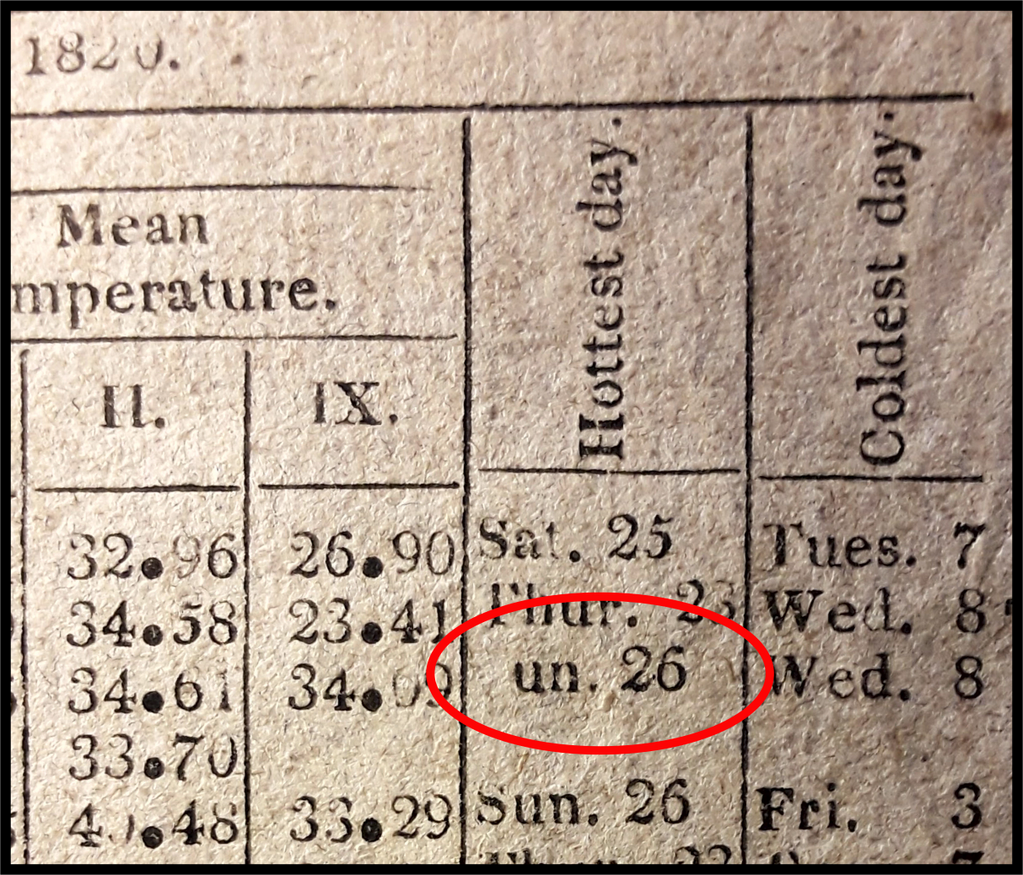
comparability of weather in sackets harbor to palmyra
Additional Information from First Published Weather Report
Some have asked about the comparability of the Sunday, March 26th, 1820 weather reports at Sackets Harbor to Palmyra. There is a good answer to this good question. In the world's first weather report found in National Intelligencer there is a column that identifies the hottest day in the month of March 1820 for each of the reporting U.S. Military Posts.
From a column in the newspaper's weather report it is possible to identify that (1) Sackets Harbor, New York, (2) Boston, Massachusetts, (3) New York Harbor, New York, and (4) Fort Mufflin (Philadelphia, Pennsylvania) reported that Sunday, March 26th, was the hottest day for the month of March 1820.
These reports show that on Sunday, March 26th, 1820, in the country's Northeast Section, in an area of about 200,000 square miles, it was a clear, beautiful day. The data is in the newspaper. A cropped photo of the newspaper report is attached to the above figure. Well-trained weather experts will have more to say how these four data points remove any doubt about the comparability of March 26th weather in Sackets Harbor to Palmyra.
Comments by Dr. John C. Lefgren
Let me try to explain why I think that the newspaper report is significant. Time-specific weather observations have high historic value. I found this data from Dr. Wheaton's handwritten report to the Surgeon General in the US National Archives. The data came from Sackets Harbor for the early spring of 1820. I made a chart for the 45-day early spring period including morning temperatures and sky conditions. Some ask how comparable is the weather chart of Sackets Harbor to the weather in Palmyra. Good question. From the tables of the 1820 newspaper report, I am able to say that four Army posts reported that the March 26th weather was the hottest day for that month in 1820. All these posts are in the Northeast Section of the county. The outside boundary for these military posts encloses an area of more than 200,000 square miles. Sunday, March 26th was the hottest day for the early spring at these military posts -- Sacketts Harbor, Boston, New York, and Philadelphia. This means that by inference Palmyra was also hot. I am sure that there are well-trained experts in weather forecasting and statistical analysis that are able to look at the four data points found in the newspaper and remove any doubt about whether or not the warm weather in Sackets Harbor on that day was an excellent indication for weather in Palmyra. On March 26th there was a major weather system covering all of New England and that weather system resulted in the clear, beautiful day that Joseph Smith remembered.
Learn More
An archive is a place where people can go to gather firsthand facts, data, and evidence from letters, reports, notes, memos, photographs, and other primary sources.
The National Archives is the U.S. Government’s collection of documents that records important events in American history. The National Archives and Records Administration (NARA) is the Government agency that preserves and maintains these materials and makes them available for research.
the first weather report published in the history of the world has the date of the first vision, sunday, march 26th, 1820

National Intelligencer was published daily from 1813 to 1867 and was for that time the dominant newspaper in Washington, D.C.
https://en.wikipedia.org/wiki/National_Intelligencer
On Thursday, July 27, 1820, this newspaper published the first weather report in the history of the world.

In 1818 Dr. Joseph Lovell, at the young age of 29, became the United States Surgeon General. His headquarters were in Washington, D.C.
In 1819 Dr. Lovell trained military medical officers to record and collect three times each day meteorological observations. By late June 1820 his office had collected more than 10,000 observations covering an area of nearly one million square miles.
Dr. Lovell org

Dr. Joseph Lovell was less than thirty years of age and with but six years of service when he became the United States Surgeon General. One of his first acts as Surgeon General was to require from all army posts quarterly reports by the medical officers on weather conditions and on the incidence and causes of diseases. The compilations of these reports have high historic value.

The world's first published weather report has the day for the First Vision that is uniquely identified as the hottest day of March 1820. That date is marked with a red oval.
The National Intelligencer under Samuel Harrison Smith had a strong connection to Thomas Jefferson, who encouraged its founding and supported it as President. It became the official newspaper of the Republican government and

Here is evidence in a newspaper that the Hand of God is found in the smallest details of our lives. Imagine going across 5,000 years of history from the earliest times of the Bible counting each day as significant to find a date that the Archangel Uriel gave to the Prophet Enoch as a mark for the first day of the Last Dispensation. The very day when God the Father and His Son, Jesus Christ would a

I have been interested in trying to find the date of the First Vision for 40 years. Can you imagine how excited I was when I got a chance to buy an original 1820 newspaper that identified that date as the hottest day in the month of March 1820 at Madison Barracks in Sackets Harbor, New York? Here it is. In a newspaper as part of the first weather report in the history of the world. I present this
Photo Gallery
How Lovely Was The Morning
Check out this great movie






